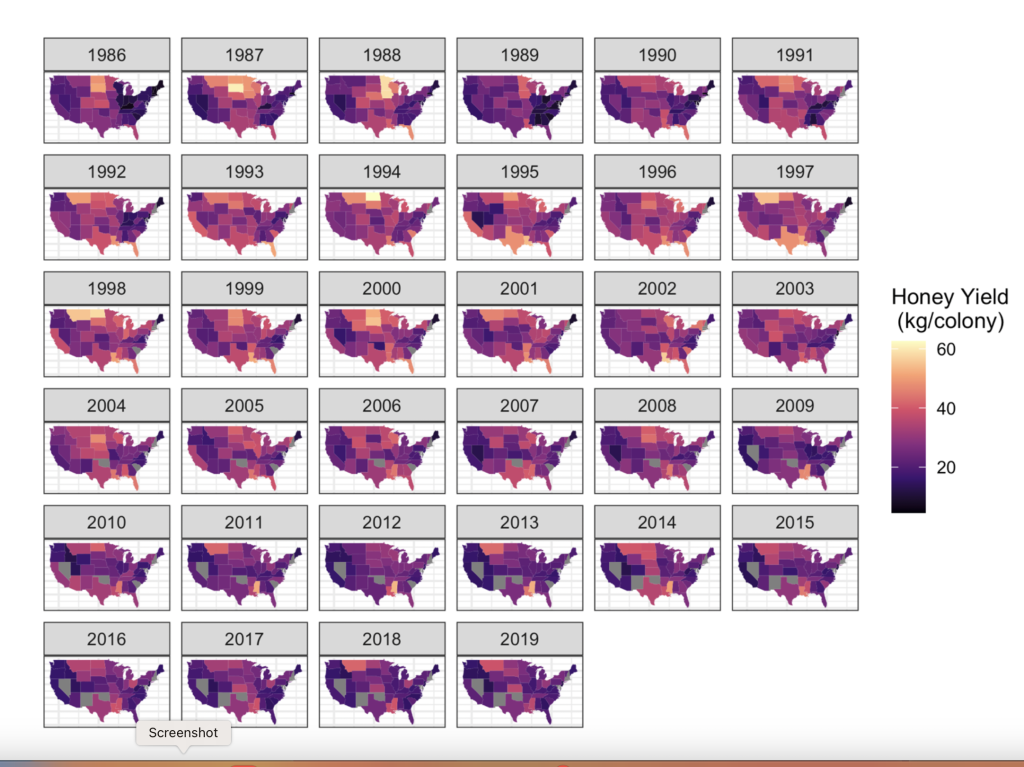Click Here if you listened. We’d love to know what you think. There is even a spot for feedback!
Read along below!
Found in Translation
A Sense of Place for Honey Production
By: Jay Evans, USDA Beltsville Bee Lab
Much has been made of the effects of drought, crowding and other temporary disturbances on the yields gathered from honey bee colonies, but a recent study suggests that two-thirds of what determines honey yields relates to the home address of apiaries. The USDA National Agricultural Statistics Service has been asking beekeepers for honey yields for a very long time, using the information to get a sense of beekeeping economics and U.S. capacity (https://www.nass.usda.gov/Surveys/Guide_to_NASS_Surveys/Bee_and_Honey/index.php). Additional national (especially the U.S. Geological Survey) and state agencies are also keen on land use and climate patterns since these, too, help make farming and other land uses more efficient and predictable. Finally, non-profits such as the beleaguered Bee Informed Partnership (www.beeinformed.org) and Project ApisM (www.projectapism.org), along with university efforts including Beescape (www.beescape.net) have been funding and exploring how habitats affect bee health and productivity.

Figure 1
In a recent study, Gabriela Quinlan and colleagues from Pennsylvania State University mined data for honey yields provided by USDA-NASS using a complex mathematical strategy. They broke historical data into two chunks, from 1974-1991 and 1992-2019. Near these break points, per-colony honey production in the U.S. went from rising nearly 50% from the 1970’s to mid-90’s to giving back those gains from then until the present time. This study does not explore the economic factors causing that decadal hump (Figure 1), but instead looks within these different time stretches to see which factors stand the test of time. The goal is to see how beekeepers or land managers can adapt to longterm trends and maintain hive production goals. It is also fun to see exactly where one’s state lies on the spectrum of expected per-hive yields and perhaps see how state-level good and bad years match one’s own experiences (Figure 2, and the NASS Honey survey). While the authors do point out naturally good regions to make honey, a few caveats suggest this study should not be your primary resource as you plan a retirement spot to finally start that sideline honey business.

Figure 2
First, the data are collected at the level of states, so they do not account for highly variable land-use or climate differences within some states. Practically, this is how USDA collects such data. While commercial beekeepers, and most of our bees, migrate across state boundaries on an annual pollination cycle, sites of honey production are generally tied to where that nectar is collected by bees and processed by them into honey. This is a result of not wanting to ship extra weight around when possible. Since state boundaries have not changed, they provide a nice constant yardstick over the decades. Second, comparing every single event or geographical difference that might impact honey yields would result in strung-out models, so the scientists leading this study did not measure all possible changes during and across such a long stretch. The authors DID analyze high-quality data for both abiotic (climate and weather, soil traits and use of the herbicide glyphosate) and biotic (soybean plantings and the enrollment of acreage in the Conservation Reserve Program, CRP) factors that impact bees.
So, what is the punchline? Yes, climatic regions with steady honey collection ‘on the whole’ remain good spots some decades later. This does not mean each state, or even the top ten, were always ranked the same, just that two-thirds of the forces that predict colony honey yields can be ascribed to ‘states’ and their associated climates. Of secondary importance is soil type (in this case soil productivity, a trait that accounts for nutrient availability, acidity and how far roots can reach into soils). Soil quality combined with climate explained over 90% of the variation in honey production in the first time-frame of this study, and over 80% in the second, the difference reflecting more recent land-use changes as well as the addition of glyphosate as a measured trait. In terms of land management, increasing soybean acreage and decreased CRP usage had slightly negative and positive effects on per-colony yields, a trend that has been explored elsewhere in experiments done with a finer grain. There are also hints that ongoing climate change will change areas of highest honey production. But, overall, the study suggests that broad areas with climates that have been conducive to beekeeping for decades continue to show this, while less-productive areas (states) are simply not getting much better.
It often helps to compare honey yield and its drivers in independent regions. Scientists in Mexico have just conducted a similar study based on hive data collected there from 1980-2012. Francisco Balvino-Olvera and colleagues compared land-use, climate and economic data to explore how these factors have impacted beekeeping over these several decades (Balvino-Olvera, F.J., Lobo, J.A., Aguilar-Aguilar, M.J. et al. Long-term spatiotemporal patterns in the number of colonies and honey production in Mexico. Sci Rep 13, 1017 (2023), https://doi.org/10.1038/s41598-022-25469-8). Colony numbers decreased in Mexico during the measured time period, arguably driven by the increased presence of Africanized honey bees, changes in land use, and socioeconomic factors. Still, honey yields per colony increased. The Mexican study, as in the U.S., suggests that terroir, in the form of soils and consequent plant health, was a large driver of honey production. Both studies also suggest that year-to-year weather changes, too hot or too cold, too dry or too wet, were large enough to shift regional honey strengths. North and Central Mexico, historically more productive areas, showed reductions in both hives and honey yields that the authors suggest reflect long-term drought conditions. These weather patterns in term might have impacted both land cover and changes in the intensity of bee management. Perhaps as expected, regions with higher poverty did not see the increases in honey yields seen elsewhere, and the authors suggest this lag is a result of limited resources to manage bees more aggressively.
Broad trends will not necessarily impact your bees as they prepare for this Spring’s bounty, but seeing how millions of hives have fared over the years can point to the strategies under your control for improving the terroir within a couple miles of your beeyards. If you are stationary, this means either being lucky enough to have sites near long-term forage or being proactive in improving what grows near you. You can, of course, also manage colony sizes and health so your foragers can exploit those riches when they flower. Migratory beekeepers can and will continue on previous paths to states with high Summer nectar flows, while also working to promote and protect large-scale floral resources. And all of us will have to be conscious of climate anomalies and changes that can squeeze honey from our beehives.







